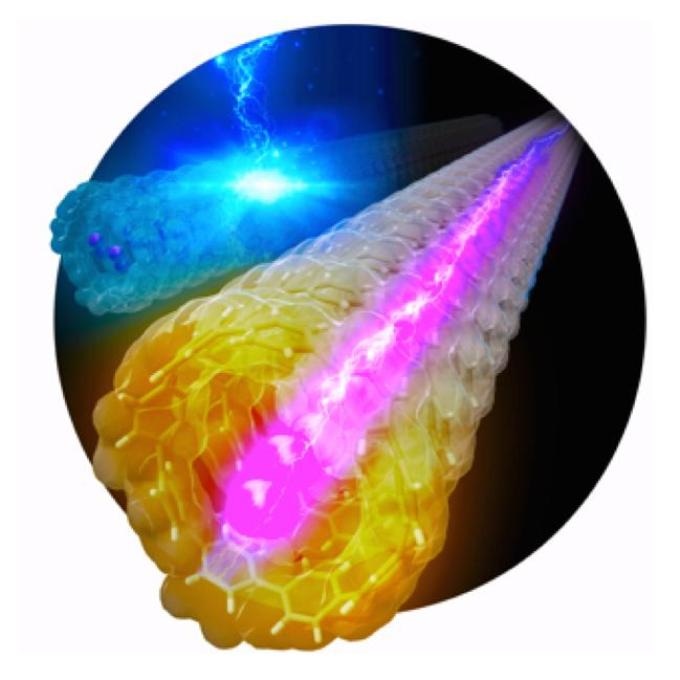Jul 25 2017
Nagoya University Researchers have recently devised an innovative technique for producing stimuli-responsive materials in a predictable manner. They applied this technique to develop a new material with the ability to conduct electricity and emit white light upon being exposed to electric current.
The new material is a blend of iodine and carbon nanorings. The innovative method devised by the Researchers can assist in producing a broad array of dependable stimuli-responsive materials that can be used in applications such as artificial muscles, memory devices, drug delivery systems and many more.
 An electric stimulus induces the hydrocarbon nanoring cycloparaphenylene (CPP)-iodine assembly to show electronic conductivity and white light emission. CREDIT: ITbM, Nagoya University.
An electric stimulus induces the hydrocarbon nanoring cycloparaphenylene (CPP)-iodine assembly to show electronic conductivity and white light emission. CREDIT: ITbM, Nagoya University.
In response to external stimuli—for example, heat, electricity, photo-irradiation and pressure—these materials modify their own characteristics. This behavior can be regulated for a broad array of applications, for example, in displays, computer memories and optical discs, and also for drug delivery systems and artificial muscles.
Scientists have been continuously engaged in research work to synthesize innovative stimuli-responsive materials in a foreseeable manner. Yet, it has been highly challenging to design and regulate the complex molecular disposition of the materials.
At present, a research team headed by Nagoya University’s JST-ERATO Itami Molecular Nanocarbon Project and the Institute of Transformative Bio-Molecules (ITbM) has devised a simple and fool-proof technique for producing stimuli-responsive materials. The outcomes of the research were recently published in the Angewandte Chemie International Edition journal.
The “responsive porous host” technique involves choosing a molecule that has a porous framework and binding a “guest” molecule to it, where the guest molecule possibly reacts to external stimuli. Here, the Researchers discovered that [10]cycloparaphenylene, or [10]CPP which is a hydrocarbon molecule comprising 10 para-connected benzene rings, was found to be a suitable host when combined with iodine (I). Iodine responded to electric stimulation by positioning itself inside the porous carbon rings. Apart from conducting electricity, it also emitted white light—an uncommon phenomenon. Naturally, various other components are necessary to acquire the white color. This demonstrates the capability of [10]CPP-I to be applied for futuristic illumination systems.
This ‘responsive porous host’ approach is expected to be applicable to different stimuli, such as photo-irradiation, heat application and pH change, and open the path for devising a generic strategy for the development of stimuli-responsive materials in a controllable and predictable fashion.
Dr. Hirotoshi Sakamoto, a Group Leader of the JST-ERATO project
The material can be produced by means of an astonishingly simple process in which the research team combined carbon nanorings (CPP) with iodine, and allowed it to become dry. The team performed X-ray crystallography and asserted that the iodine molecules get arranged in a line inside the hollow core of the ordered nanorings.
The Researchers attempted the process by making numerous modifications in the mixture, by altering the number of carbon nanorings. Consequently, they discovered that a count of 10 rings resulted in a highly dynamic iodine atom movement and the highest sensitivity to alterations in outside environments.
Upon applying a direct current [10]CPP-I, the bulk resistivity of the specimen was roughly 380 times low, suggesting that instead of resisting electrical transmission, it conducted electric current. The bulk resistivity of mixtures containing 9 or 12 nanorings was not found to decrease this much. These outcomes indicate that the nanoring assembly’s pore size regulates the reaction to electrical stimulation.
One of the most difficult parts of this research was to investigate how the electric conductivity of [10]CPP-I is turned on by electric stimuli. Although it only took us about three months to synthesize the molecule and discover its electric-stimuli-responsive properties, it took another year to discover the origin of its properties.
Dr. Noriaki Ozaki, a Postdoctoral Researcher of the JST-ERATO project
Finally, the Researchers interpreted the manner in which [10]CPP-I’s electric conductivity is triggered by electric stimuli by the application of fluorescence spectroscopy, Raman spectroscopy and X-ray absorption near-edge spectroscopy (XANES). The investigations demonstrated that the iodine atoms contained in the carbon nanorings form expanded polyiodide chains upon electric stimulation, which led to the electrical conductivity of the material.
In addition, the team found out that electric stimuli has the ability to alter the photoluminescence color of [10]CPP-I from green-blue to white color. White luminescence indicates that [10]CPP-I’s fluorescence spectrum extends over the entire visible light range. Spectral broadening was the result of uneven distribution of the electronic structures of carbon nanorings due to the forming of polyiodide chains. [10]CPP-I’s white luminescence is an uncommon instance of white illumination material that has a single molecular assembly. In general, white light emission is accomplished by combining various components of different colors.
We were really excited to develop this simple yet powerful method to achieve the synthesis of external-stimuli-response materials.
Professor Kenichiro Itami, Director of the JST-ERATO project and Center Director of ITbM